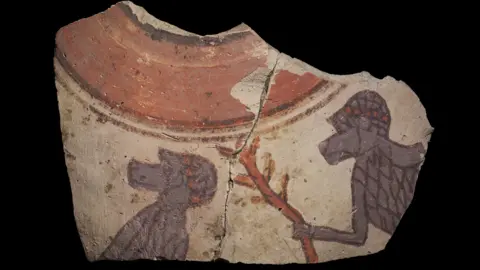Creatures of the Nile focuses on the animals that were central to life in the ancient civilisation.
Dr Gina Criscenzo-Laycock, who is curating the display at the Victoria Gallery and Museum in Liverpool, said: “People usually think of mummies but we wanted to bring out a different side.”
“Egypt gets a lot of attention and so do animals. This exhibition bring these things wonderfully together.”
 University of Liverpool
University of LiverpoolDr Criscenzo-Laycock said she hoped the free exhibition would “build up a picture of the natural environment” of Egypt and Sudan – where the White Nile and Blue Nile unite after flowing from Tanzania and Ethiopia respectively.
“While we have borders, animals do not – we’re looking at the area as an ecosystem,” she said.
She said there was a misconception that those living around the Nile were “obsessed with death but actually they were obsessed with life”.
“They conceived the afterlife as an idealistic version of real life.”
The display showcases pottery etched with animal-inspired designs and their incorporation in hieroglyphic writing.
It also highlights how creatures were a source of food, with remnants used for clothing, tools and jewellery.
Some animals were hunted to extinction, while other wild species moved due to environmental change and increases in human and livestock population.
 University of Liverpool
University of Liverpool
Dr Criscenzo-Laycock said the exhibition would show “how humans view animals from the point of view of ideology”.
Some of the most recognisable Nile symbols are hybrid figures, particularly the human-headed, lion-bodied Great Sphinx of Giza.
“Animal imagery was used as an expression of divine power but also human agency,” said Dr Criscenzo-Laycock, who is based at Garstang Museum of Archaeology.
She highlighted the goddess Taweret, shown as a hippopotamus, who was “evoked to protect mothers in childbirth”.
“It’s because they’re terrifying. They’re incredibly protective of their young, so they will even kill crocodiles to protect them.”
 University of Liverpool
University of LiverpoolMore than 250 items will be on show from this weekend until 5 October at Victoria Gallery and Museum, including objects loaned from National Museums Liverpool and Manchester Museum.
The museum world is currently the focus of a worldwide debate on the removal – often illegal or unethical – of historic valuables from countries.
Dr Criscenzo-Laycock said it is known “where and when” the displayed items were excavated, and that no repatriation requests had been received.
“We’re confident they were legally acquired and exported from Egypt and Sudan.
“We want to use these collections to increase knowledge and interest in these countries – to be of benefit,” she .













































